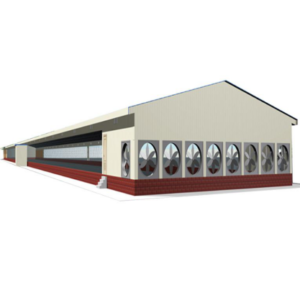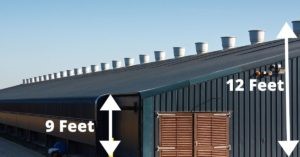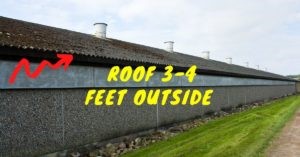Tips for Site Selection and Construction of Poultry Farms
A small mistake during construction of poultry farm. So you have to understand the importance of basic fundamentals of poultry’s design. There are many points can influence the growth of poultry’ birds. And can increase the profit of your poultry farm. Best poultry farm design control temperature, and helps to remove unwanted gases like ammonia from poultry farm. By this birds get comfortable environment and stress get reduced, and the effect of Viral and Bacterial diseases get reduced.
First Understand The Reason for Good Poultry Design.
There are many micro-environments which influence the factors of better production efficiently, and explain the importance of temperature, relative humidity and ventilation for removal of excess unwanted gases like Ammonia,carbon dioxide etc in poultry sheds.
If The Bird is in a Comfortable position, Birds will be stress free, Stress free bird means less Chance of Disease & more chance of better production.
If a bird is in stress condition, the body has to spend huge energy to cope up stress & Bird will be more prone to Viral & Bacterial disease.
Remember Single Mistakes in Poultry Shed Design can cause blunder.
It also has been observed, Respiratory, digestive and behavioral disorders are more likely to occur in houses in which the climatic conditions are not up to standard or favorable for poultry ‘birds.
Note down below Points during constructing a poultry farm.
1-Long axis should be East To West and width extending North-South in tropical countries.
2- Foundation Solid concrete blocks and bricks with 1.5 to 2 feet below the surface and 1 to 1.5 feet above the ground level.
The Solid reason for Extra Strong Foundation is, If in future you wish to plan a double story poultry sheds, then You no need to worry about its Foundation again.
3- Floor – A cement concrete floor will eliminate disease problems and help in easy cleaning and disinfection and reduce problems due to insect & disease.
Concrete floors are always better for commercial broiler chicken poultry farming.
Initially you can start without Concrete Floor, but without Strong Concrete, litter absorbs moisture from bottom of surface & can increase moisture level of Litter which can cause extra gases production resulting stress on birds and poor production & it increases the chances of Respiratory disease.
4– Width of poultry shed must not more than 30 feet. If the width of the shed is more than 30 feet it can cause ventilation issues. But you can increase the width in EC (Environmental Control )houses up to 40 feet. But remember only if you have strong backups of electricity & 100 % sure about the E.C.System and backup of electricity will never fail.
But I personally recommend 30 Feet Wide sheds are better. There is no limit for length of your poultry House.
5- Poultry’s farm height from foundation to the roof line from both sides should be 9-10 feet
Poultry Farm with Slope For Single Story is in middle 12 Feet and from outside its only 8-9 Feet.and at the center 12 feet With slope from centers to sides.
In case of double story sheds it’s not applicable.
In case of cage houses, the height is decided by the type of cage arrangements as per manufacturers. (3 or 4 tier)
Example– Sides of Shed Should be 1.5 feet -2 Feet & will be covered by Bricks or concrete & pending Area Will be open & covered by Wire mash.
Small Side wall For Poultry Shed.
In cage houses, avoid side wall or discuss with the company, which is installing it.
6-Hinges on every wall on net, Up & Down.It Give Good grip for Curtains.
7– The roof at the eaves (Chhajaa in Hindi ) should at least extend 3 to 4 feet (1 to 1.25 meters.)
Poultry Farm Roof Outside
This Point is very much important, because it don’t allow the rainy water in rainy season entering in farm.
8-Doors -Single Door is considered better for little easy to operate. But either single or double door both way as you wish depending only on cost.
9-Roof-You can choose any type of Roof,Concrete,or Any type of strong Sheets, tiled, asbestos, or concrete depending upon the cost involvement.
Different types of roofs are shed, gable, half-monitor, full-flat concrete & many types .But Gable type (Gable type Picture above)is most preferred in tropical countries like India Outline Roofing material.
If land is costly & you wish to plan double story shed than flat concrete sheds are also preferred.
The most important insulation requirements are in the roof. A well-insulated roof will reduce solar heat penetrating the house on warm days, thus decreasing the heat load on the birds. In cold weather a well-insulated roof will reduce heat loss and energy consumption needed to maintain the correct environment for the chick during the brooding phase, the most important time in the development of the chick.
10-The roofing materials used may vary based on the needs, requirements and budget of the farmer. The various roofing materials are straw, coconut leaf, palmyrah leaf, light roof (Asphalt coated), tiles, plastic, asbestos, aluminium, fibre glass, etc.
Try the material which leads the roofs cool. Because birds hate high temperature after few days.
The material used for covering roof should not fovor to increase temperature.
11-Side wall- As almost side wall are only -1.5 feet high outside from the bottom of Poultry’s shed floor. Other Area is only covered by Wire Mash.
But Wire mash only should not allow entry of any insects,snake or lizard inside your Poultry Farm.
12-Door Opening- The door must be open outside mostly in deep-litter poultry houses.Foot Bath-The size of door is preferably minimum 6 x 2.5-3 Feet.
13-Many Poultry Farmers construct a foot bath fill with a disinfectant at entry of Poultry shed.
This is wrong practice. Because by this wet shoes enter in Poultry farm and Can make Litter wet.
So this Practice must be done at the main entrance of the Poultry farm, instead of the entrance of the shed.
14-Floor must be flat concrete with slope on desired area, Floor must have a slope on both sides Horizontally & Vertically for easy cleaning and flow of water should be impermeable to parasites and easy to clean other materials. But remember flow should be proper without any mistake.
15-Water tank must be of large capacity, in any emergency situation, you must have stock of Water.
16- Godown- Feed storage room must be big depending upon the capacity of Farm and store room should be extra for storage of poultry equipment’s in case of no use. Godown must have a outside door of such type, when you receive poultry feed, vehicles don’t have to enter in poultry farm .
17-Environmental control sheds are better than traditional sheds.
But initially, if you are planning to make Traditional Poultry Sheds, than Option of Installing Environmental control system must be there, So that in future you should not suffer extra Loss.
18- If using Plastic Pipes for water supply, Underground fittings are best. Some Poultry Farmers suffered huge loss, if accidentally pipe broke & water flow can disturb the internal environment & cause huge stress.
19-Electricity System- Main Electric system must be outside of the poultry’s house. So that birds must not be disturbed for small work related to electricity.
20-Generator- An Insulated Generator room must be separate & little away from Poultry Shed & Insulated to reduce noise or you can use Silent generator.
Never make Generator room so short, in any issue or trouble, it can be repaired easily.
21-Office – Office must be near the entry of Poultry Farm .Front of office must be covered with transparent glass. So that every entrance & activity could be noticed easily.
22-If planning to extend your poultry Farm than difference between one shed to another shed should be minimum 50 feet , You Can reduce it ,But I recommend you 40-50 Feet is better.
23-Never forget to leave extra space on the last boundary of your poultry farm. Because if someone constructs any property, their wall can cover your poultry farm’s boundary.
So always leave space if some other person constructs anything near the boundary of his property, you must not have fear of covering your poultry farm.
You can leave space of 30-40 feet at your land boundary.if you feel situation like this.
24-In the Corner of Poultry Shed a Postmortem Space with a Table must be present with hand wash facility.
25-If Planning a Big Poultry Farm, Labor Quarter with good ventilation with Separate Toilet Must be built as per requirement
26- Always remember, If Planning a small project then, you initially must not plan big office & Unnecessarily luxury. Because it increases the cost of Poultry Farm.
Tips for Site Selection and Construction of Poultry Farms
Site Selection
- Site selection is an important task in starting broiler farming, but unfortunately, we do not have much control over it.
- It is because we have to start farming on the land which is available to us.
- In short, we have to make that land suitable for our requirements.
- Some basic points should always consider before making any decision
- Land should have good road connectivity
- There must not be any water logging issues and must have elevated land
- It should be safe from predators & stray animals, it must have good fencing
- Ground water must be clean and clear, both bacteriological & chemical
- Should not have water bodies around the farm, it attracts the water birds which carry bird flu, ND and other diseases
- Must have expansion provision in future
- Availability of electricity (presence of electric poles/ provision of meter etc)
- Presence of electricity (after assessing this, you should take the decision of purchasing generators or solar panels as per the need)
- Consider other farms in the surroundings which may be a potential source of diseases
- Surrounding trees may have both positive and negative effects
Shed construction
- After site selection, the next step is shed construction. While constructing it you must need to remember some basic points.
- Ventilation and microclimate control are very important points.
- Sheds are of 2 types (1) open-type sheds in which environmental factors are not easy to control (2) closed sheds which are also known as environment-control sheds.
- In India, more than 90% of the sheds are small open-type sheds in which 1000 to 10000 birds are kept
- In open-type sheds, only natural ventilation occurs, for the width of the farm should not be very large. The optimum width of the farm should be between 24ft to 28ft.
- Durable, high-strength farms gave higher returns than low-cost kaccha farms.
- The height of the side wall would be around 1 to 1.5ft from the ground and after that galvanized wire net should be erected.
- While making the side wall, keep in mind that the wall should be under the ground at least 2 feet and filled with RCC so that burrowing vermins like mongoose, rats or other animals may not dig it and enter the farm.
- Similarly, the strength of the wire net must also be considered while putting it above the wall.
- Pillars can be made of RCC or Iron. Iron pillars are easy to disinfect but they need more care because if they are not well painted they can be rusted during farm cleaning (fogging and fumigation). RCC/Brick/Soil can harbour deadly IB, gumboro and other viruses for long periods.
- The ends of the farm are made up of brick completely
- The roof of the farm should be made of asbestos, iron or plastic must not be used.
- For a durable roof, an iron truss should be made.
- The farm should be oriented in an east-west direction because it allows sunlight in winter and shade in summer.
- If your budget allows then you can make RCC or brick (pucca) flooring, it is easy to clean and disinfect. Coccidiosis and other gut problems would be less on the farm.
- The Pucca floor is also good as it cannot be breached by vermin (like mongooses and rats).
- Otherwise, you can keep it kaccha like many other farms but that has its own problems as discussed above.
- Roofs can be painted black from the inside and white from the outside, having benefits in hot humid climates.
- Outside & inside of farm proper provision of water tanks should be made. Outside tanks must not be placed in direct sunlight. Because if the water temperature exceeds 22-250C then water intake declines, especially in summer.
- A small water tank inside the farm is good to keep for medication purposes.
- Curtains have a very important role in controlling the microenvironment in farms. Good quality, mechanically controlled curtains should be placed on the outer side walls. In manual curtains, labour always remains reluctant while handling manual curtains.
- Surrounding farms should not have high grasses or other vegetation, which may become shelters for vermins, that cause physical harm as well as carrier of the disease.
- Other animals like desi chicken, pigeons, dogs, cattle or goats should not be kept in same premises.
- Litter disposal should not be done near the farm
- Do not keep other aged birds on the same premises, this is a very deadly decision in long term. Those farm runs well in the start but closed down in future or give high losses very frequently.
- Distance between 2 farms should keep at least twice the width of the farm, but keep it as large as possible.
- Some farmers kept feed on the farm which is not good practice, keep feed in proper stores away from the farm and also imply proper pest control program.
- Feed mills should also install away from the farm
MANAGEMENTAL GUIDELINES FOR SETTING UP A POULTRY FARM
MANAGEMENTAL GUIDELINES FOR SETTING UP A POULTRY FARM
Compiled & Shared by- This paper is a compilation of groupwork provided by the Team, LITD (Livestock Institute of Training & Development)
Image-Courtesy-Google
Reference-On Request






